By Bonnie Cassen
The fight to save the historic Holy Trinity Church in Huskisson encompasses battles over every bit of dirty local council politics. The conservative, developer-controlled bloc on Shoalhaven Council has a reputation dating back many decades and cares not one bit for community wishes, best practice, ethics or anything one would usually expect from their elected council representatives.
The Anglican Church washes its hands of this immoral act that they encouraged, supported and acted to facilitate.
When the Bishop of Wollongong cold-called a community member, Tim (who knows why?), he was at pains to stress that the church had done nothing illegal. Tim agreed. Not illegal, just immoral. The Bishop did not like that.
I too received a response from the Bishop of Wollongong who oversees the area for the Sydney Diocese. I had been trying to get a phone response from the new Archbishop of Sydney, Kanishka Raffel, but instead received the following statement from Peter Hayward, Bishop of Wollongong:
“We have been communicating with local Indigenous groups and are concerned that significant issues have now been identified. However, the land has been subject to a contractual obligation since May 2019 and it has now been transferred to a new owner.”
Community members have been writing to the Bishop about these ‘significant issues’ for years to no avail. And I couldn’t find any local Indigenous groups who said that they had been communicating with the Bishop. The lament of the Aboriginal people, including the Jerrinja Aboriginal Land Council that owns the land adjoining the church site, is that no-one bothers to communicate with them.

Back in 1998, when Shoalhaven Council was putting together its first heritage study, the Holy Trinity Church at Huskisson was one of the properties of local historical significance that Council staff, community members and historical researchers had earmarked as worthy of protection.
The church was designed by Cyril Blacket in 1936, replacing the original church erected around 1890 not long after the land was gifted to the community for a place of worship.
Architect Blacket designed many fine buildings including the School of Arts in Nowra and the Soldiers War Memorial Gates at the Nowra Showground.
When Shoalhaven Council lodged its draft LEP back in 2005 it included the entire church site, including the graveyard, in its heritage inventory. Heritage experts believed it worthy of heritage status and its protections, and NSW Heritage agreed.
However, in the most confounding of backflips, after some lobbying from the Anglican Church who didn’t want the heritage listing, Shoalhaven Council sought to withdraw the draft LEP so that it could review the plan and, against the recommendations of the State heritage experts, ultimately voted through the removal of a number of heritage items in Huskisson, including the Holy Trinity Church site.
The story pans out that the Anglican Church believed a heritage listing would limit the sale price it would receive for the property should they sell it. And the plan was exactly that, to sell it. In 2017 when the sale of the land was on the table, the local parish argued that it had outgrown the Blacket building. The congregation moved to a hall at Vincentia Public School.
Interestingly the Anglican congregation in Huskisson isn’t that large anymore, if it ever was. Apparently a large number of its members were so disgusted with the Church’s position on the sale and the questionable ethics of its actions, they no longer attend the Church. Instead they choose to meet informally as a group, ironically, in a local hall.
For dealings being undertaken by a holy institution, one would think that ethics and morals would always come into it. That respect for community and people and heritage would be prized and held in high regard. That human rights, democracy, sovereignty and Aboriginal recognition and respect would be upheld at all times.
This clearly turned out not to be the case. It is difficult to know the level of insistence behind a letter of intent. There is only limited correspondence publicly available, and we have no idea of any phone calls or meetings that may have been part of the conversation. It does seem odd that a Councillor, the mayor no less, would act so strongly on one representation, the Anglican Church, while ignoring the huge number of representations against.
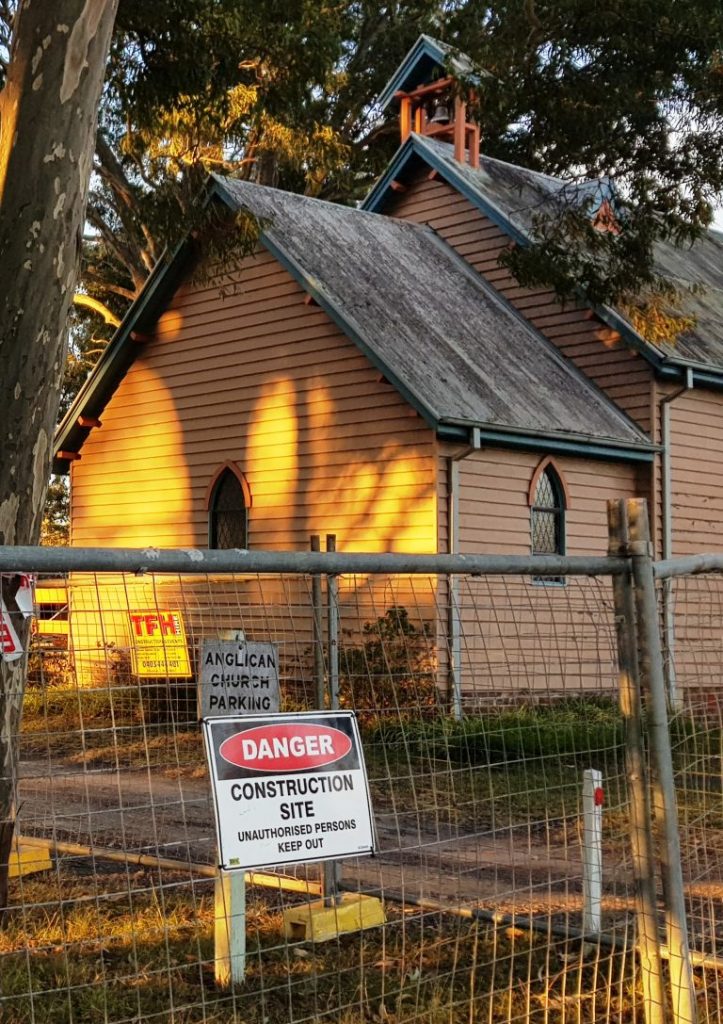
In 2006, the Watson-led Council argued that the heritage listing wasn’t necessary for the Huskisson church on the grounds that sufficient similar items already existed in the area. Apparently, a gothic carpenter-style church in Sussex Inlet and a Victorian gothic revival-style sandstone church in Milton were sufficient heritage listings and no others were necessary in the area. Huskisson presents a very different picture and a separate aspect of our cultural history. The Blackett timber church is indeed unique in its own irreplaceable way.
The Council also seemed overly concerned about development opportunities that the church site may otherwise open up – a listing might inhibit plans for Huskisson’s future as a tourist gateway. As if historical interests would somehow inhibit this aim.
In 2018, when the intended sale of the land became public, the community applied to the NSW Heritage Council for protection. The Heritage Council agreed. It is puzzling as to why the then Minister for Planning, Gabrielle Upton, didn’t seek to approve the recommended Interim Heritage Order over the Holy Trinity Church.
What is clear is that while local heritage significance can absolutely be established, the Heritage Council was indicating that it could perhaps have been considered for the higher level of state significance.
The story told by this little one-and-a-half-acre lot of Country is a piece of combined history, settler and Aboriginal. A compelling and meaningful story not to be forgotten, and not to be bullied away by development-hungry colonial mindsets, tokenising attempts at consultation, insulting and patronising.
There is an abundance of evidence of Aboriginal life in the Huskisson area, where occupation dates back over 6,000 years to when the low-lying plains were flooded over, leaving Jervis Bay much as we see it today, although now obviously plundered.
Margot Curtis from the Huskisson Heritage Association told me that local settlers were granted mining licences for ancient shell middens. These were burnt to produce lime for the building industry. A traditional walking trail that traverses Woollamia and crosses the church site on the way to the coast is visible in aerial shots.
What’s happened in the Shoalhaven, like in too many areas in Australia, is that councils get taken over by developers and the community wishes get shut down. Back in 2005 Mayor Greg Watson altered the rules so that if any property owner objected to a heritage listing, the property would not be listed.
NSW Heritage says on its website that “listing on the State Heritage Register means that your place or object has been recognised as having particular significance to the people of NSW. It has been identified by the community as an important place that enriches our understanding of the history of NSW.”
The Registry doesn’t say that it is up to a council or a mayor to set the agenda on a state heritage listing. It doesn’t say that a council or mayor has veto rights over community concerns.
Listing a land or building on the local Heritage Register does not stop you from making changes to your property or undertaking additions or new work. The listing is simply a way to ensure that the new work or new use is compatible with, or complements, the heritage of the place. The Huskisson Hotel is listed for goodness sake.
For the church site, the Huskisson Hotel front man Steve Bartlett proposes a 5-story high rise hotel with gambling and alcohol. This is simply not compatible with the ideology of a place of worship. Perhaps this explains the fervent fight to stop a heritage listing at all costs, and equally the community’s vehement response.

However it isn’t just Christian tradition that puts value on views and high positions. It makes sense that this position would also be significant to Indigenous people as well. If you happened to be buried on that site, you would have a view line down to Shark Net Beach, where there was a traditional Aboriginal camp or settlement. You would also have a view through Currambene Creek to Bilong, which is near where Myola is now and which was a traditional female burial ground and highly significant land.
It makes a lot of sense that the land that European settlers would value is also the land that the Aboriginal people would value.
History doesn’t lie.
We know that when the park in front of the church, White Sands Park, was gazetted as a park back in the 1890s there was an exemption in there, granting Dan Carpenter access to live on a piece of land for the rest of his life. Dan Carpenter was related to Queen Mary who was married to James Golding, who was known as King Billy and who is buried on the church site.
Dan Carpenter’s land is where the car park now sits near the pub, overlooking the bay. Dan Carpenter is thought to be buried on the Church site. There are many signals of Aboriginal Peoples activity in the area and that this Country is highly significant Indigenous land.
Council flaunts an archaeological wisdom that says that if you live near the coast you bury in the sand because it's easy. When you add a cultural lens you see that this may not be the case at all. Evidence tells us Aboriginal people might choose to bury their dead somewhere that's a highly significant place for them, with views in all directions across your country.
Many believe it is insulting to Aboriginal people, who would have had access to all sorts of ways of burying, particularly after colonial settlement when a variety of tools and shovels would have been available to them. Aunty Julie Freeman, an elder from Wreck Bay, is very strong on the fact that you bury people with a view, looking out across what they valued. Of course they valued Jervis Bay.
Recently Hunter Geotechnics did the ground penetrating radar survey of the land. This is a leading firm for establishing burials, considered one of the best in the field. Their report is really clear, confirming over 50 graves with a high degree of confidence. Overall, the survey has located ‘seventy-three areas of disturbed soil most likely to be associated with unmarked grave shafts and/or funerary urn burials’ (p 25). They are not in neat Anglican rows.
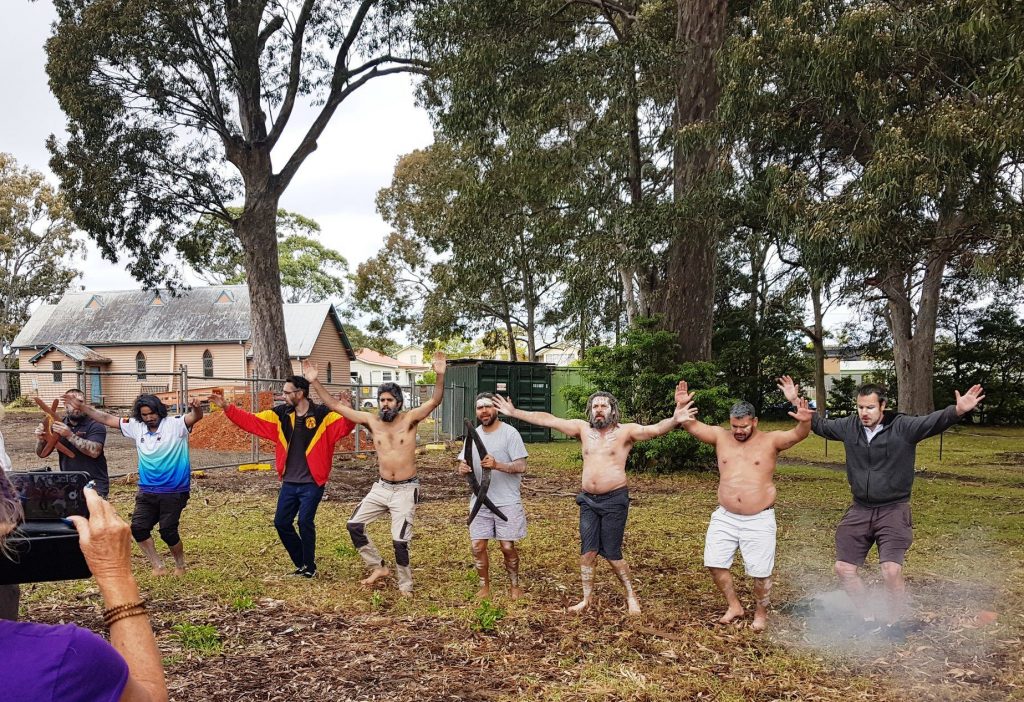
This report also says there are many more buried on the Bowen Street side of the land. Thinking logically and mapping out an established graveyard, you would expect it to extend out onto the footpath and into the street as well. There is a record of a grave in Hawke Street on the other side, near the front of the church. This suggests these burials were prior to the streets being laid out.
Many pointers confirm that this is a traditional burial ground. It is beyond comprehension that Shoalhaven Council refuse to accept this evidence and want to desecrate it even further by scraping and digging it up to ‘prove’ its existence.
The church traditionally had a missionary attitude towards Aboriginal people and welcomed them in. Many Aboriginal people took up Christianity and are buried on the site with Anglican rights, including James Golding who was buried there in 1905.
There are written records of King Billy’s burial and a death certificate confirms his daughter Rebecca was also buried on the church site in the 1930s. This is considered late for a burial in Huskisson as by this time most people had cars and burials took place in the more formal Nowra cemetery. Rebecca’s burial in the 1930s possibly indicates that concessions were made for local Aboriginal people to be buried on their own significant land.
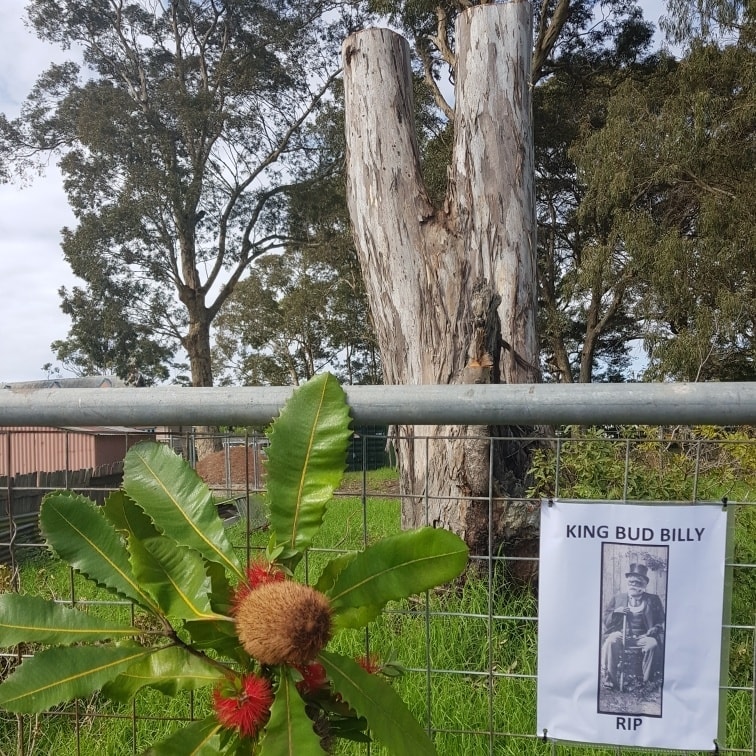
The situation is indeed sad and lacking any respect for the word and wishes of the Aboriginal people. The developer bloc on council voices respect and concern for the Jerrinja people, but although not experts themselves by any means, choose to disregard the findings of the Hunter Geotechnics report. The survey didn’t find any doubt as to the authenticity of the graves, using the term “high confidence’’.
Despite the overwhelming evidence contained within the Hunter Geotechnics report, Councillors Watson, Gash and others thought they knew better than the experts. They disputed the existence of so many graves, calling them ‘anomalies’ and possibly wombat burrows. The Council then voted to request an exemption from the Heritage Act to allow ‘scraping’ to further establish the number of graves. This process of shallow excavation uses heavy equipment across the graveyard. Where is the respect for Jerrinja people in that?
The community questions whether the scrapings will satisfy council or will it want yet more tests, this time to establish whether the remains are European or Aboriginal. Will they demand expensive DNA tests be carried out on all remains? It doesn’t take CSI to work out that it is very obvious a lot are Aboriginal.
“These aren’t anomalies. These are loved ones,” Charlie Ashby told me. “These are people who held knowledge. Our people, people who survived, that held the knowledge and shared it. These people have stories.”
The Jerrinja people, like the rest of the community, want to know who council think they are to come along and say they don’t like the evidence and don’t want to protect this piece of culture but instead want to profit from its sale.
“That’s what speaks volumes to me,” Mr Ashby said, “that’s what speaks volumes to people in the community regardless of whether they’re Aboriginal or not.”
“For me as a proud Aboriginal person growing up, I never thought that one day we would have to fight the fight that our old people had to fight, for basic human rights.” Mr Ashby said. “We thought that by the time we got to their age, we could live our dreams and be what we want to be in life but instead the fight has been passed on to us and we’re still fighting the same fights they were fighting. And that’s really disheartening.”
“I think if it was non-Indigenous explorers buried there this would be heading in a very different direction,” Mr Ashby said.
Experience has told Aboriginal people that councils appear to listen, and then do what they like anyway, making money is always more important than cultural ancestral history. When issues come up, as they inevitably do, the trauma kicks straight in, the results already known, the fruitless exercise of ticking boxes frustrating and insulting. It is councils and government departments looking like they are doing the right thing, the consultative thing, when in fact all they are doing is an appeasing process.
For a brief moment it seemed that the appointment of a new Anglican Archbishop might result in a better outcome. Born in England to Sri Lankan parents, Kanishka Raffel is the first person of non-European background to hold the office.
There was good reason to be optimistic. Kanishka Raffel was said to be a strong advocate for reconciliation with the Indigenous community – and not afraid to put uncomfortable truths about this on the table.
On 24th June he wrote to the Huskisson Heritage Association indicating that he regarded the issue with the “utmost seriousness” and was “particularly conscious of the deep feeling of the Indigenous community.”
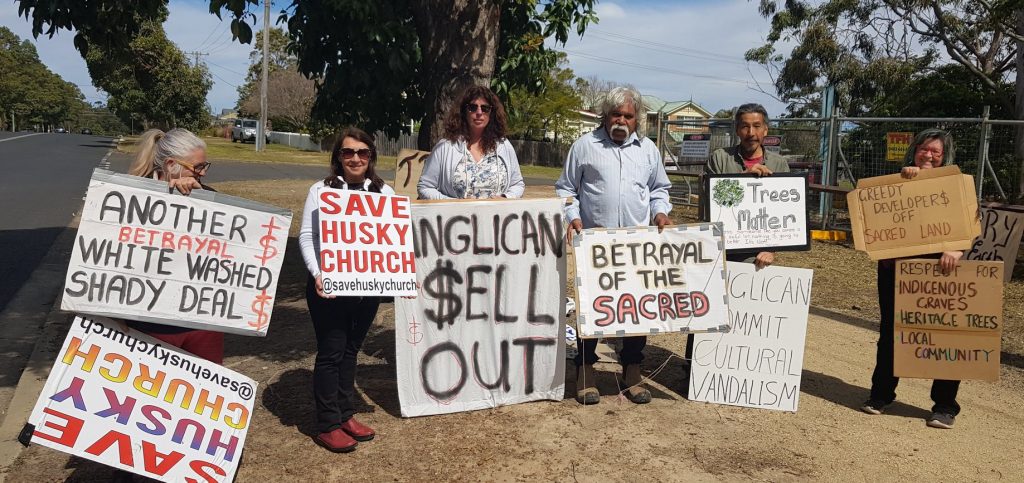
About a week later the Anglican Church finalised sale of the property and washed their hands of any involvement.
Three thousand signatures on a petition and huge amounts of correspondence ignored, a site that meets the criteria for a heritage listing unable to get across the line, Aboriginal heritage orders unprocessed, reports confirming over 50 graves with ‘high confidence’ ignored. The facts stack up, the misrepresentations and disregard for evidence smelling fishier the further you dig.
With neither the Huskisson Anglican Church, Shoalhaven Council or the developer willing to see reason, and everything back in Council’s lap to work out the details, there remains a lot of unfinished business. The site is still not rezoned, there are representations to the Heritage Council and to the Federal Minister for the Environment still unresolved and the opposition is growing for the next round of the battle.

One of the most puzzling pieces of the jigsaw is the apparent availability of the police to be used as a private security service. Able to be summoned by the developer in anticipation of (not reaction to) trouble brewing – a handful of peaceful community members protesting at what was happening and being physically hauled off site. Of course this is ridiculous over-reach by the police, and of course peaceful protest is not a crime in a democracy, but that is what happened. It looked to witnesses present like peaceful protestors being unnecessarily manhandled by police at the developer's behest.
Indigenous people once again feel literally walked over - their heritage disrespected, unacknowledged and willingly trashed. The big question on everybody’s lips is why this time?
Some say Shoalhaven Council are doing this for themselves, perhaps for glory, perhaps for money. It is certain they were doing it for the Anglican Church, and equally certain they're doing it for the developer. In the process local people are being insulted. The vast majority of the community wants to save the former Holy Trinity Church and this important site of cultural heritage. It’s the right thing to do.
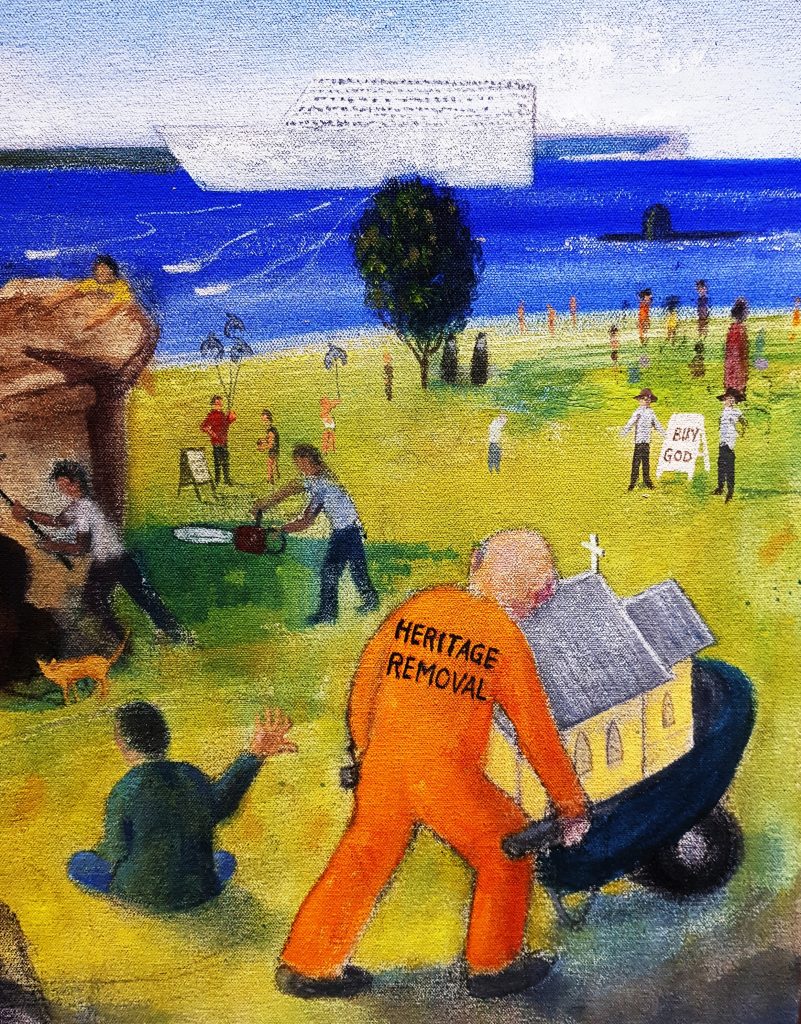
Photo supplied
For further detail and progress on the Huskisson Church development visit the Huskisson Heritage Association webpage.
Feature image: Holy Trinity Anglican Church Huskisson. Photo supplied

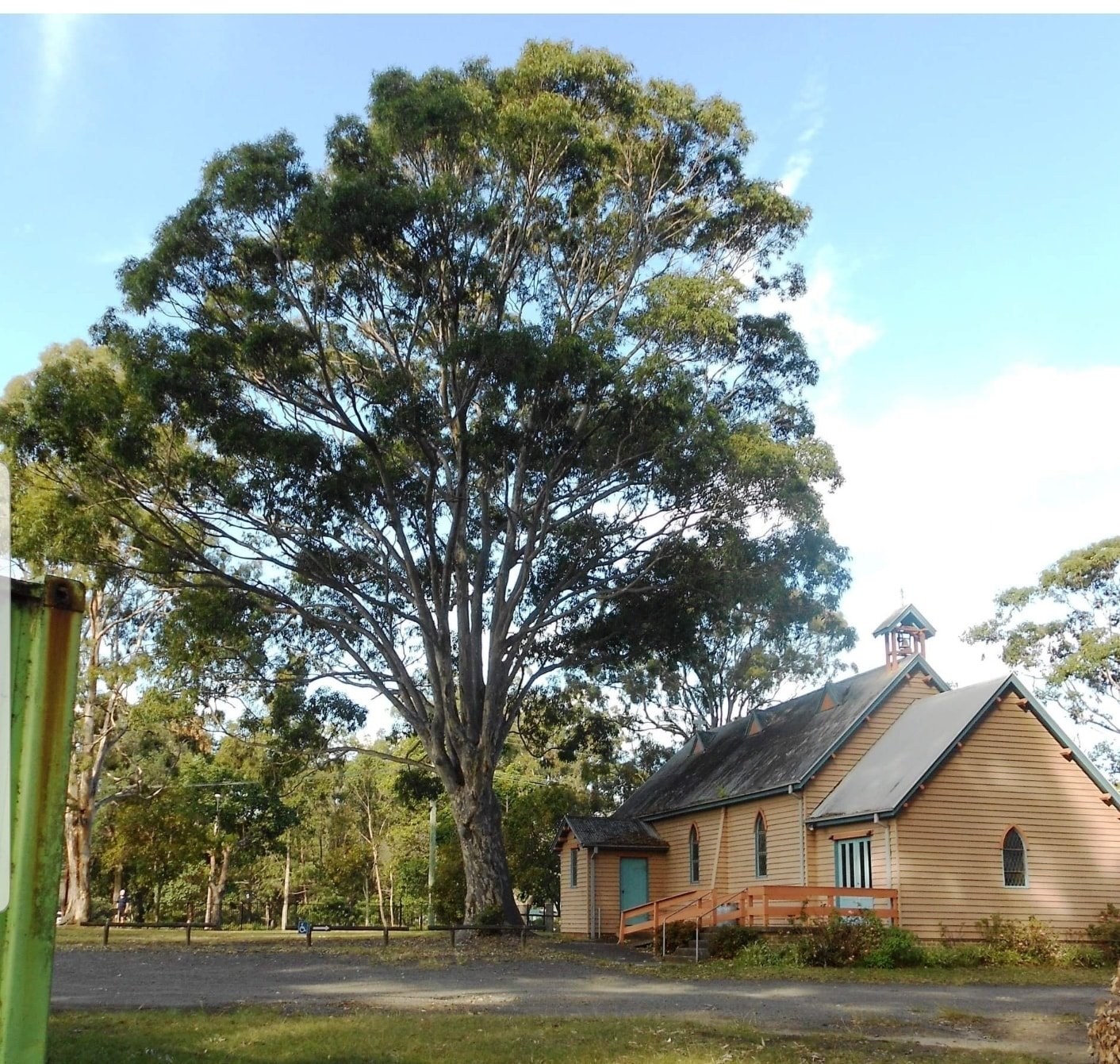

I'm absolutely horrified by this. How disrespectul. What a disgraceful bloody council. My grandfather built a holiday house at 50 Currambene Street in the 1930s. Generations of my family have enjoyed this beautiful reserve, the tall gum trees and wildlife. This can't happen and I am prepared to come to any protest if at all possible.
My father Peter Stark, who helped restore the church and involved with restoration of the Lady Denhman, wouldn't want to have the stated historic legacy it represented to disappear. His name is on the outside sign of the Woollamia Bush church in his honour of restoration.
An interesting article Bonnie. Thank you for doing writing this. Heritage in this Council is not respected as there is no full time Heritage Officer or Heritage Adviser. They would prefer to remove in the name of progress. It is not surprising the site was sold because not only is Andrew Guile a Councillor, he is but he is the Director of Risk and Compliance of the Anglican Diocesan Services Canberra and Goulburn and also its Corporate Affairs Manager.
A comprehensive summary of what has gone on! And the amended picture indicating a huge range of threats. Thank you Bonnie for this articulate work, this article in itself is an important record.
Great article, thanks Bonnie. What are you thinking though when you expect that dealings by a holy group would have ethics and morals ??? ... where are the ethics and morals of our so called "Christian" Prime Minister? Where are the ethics and morals of supposedly Christian Guile? Sadly so many Christians lack an ethical bone in their bodies.
Thanks Bonnie - an excellent article. You mentioned that the land was originally "gifted to the community" - not the church, and it seems that the church were acting as custodians. If the church no longer wanted this role it should have been handed back to the community. I question the church's moral right to sell the property.
Excellent and informative article Bonne.
This is very sad & frustrating to read. The Shoalhaven Council has a long history under Watson & his cronies to push development… it is obvious everywhere on the this coast …
The Anglican Church are equally to blame as it is all about the holy dollar.. ( in this case) the beautiful old Nowra town Hall was another loss.& many of the old buildings I grew up with in the 50’s & 60’s. the area is losing so much history because of these dinosaurs running the council ( clearly in the pocket of developers) ..
All we can do as residents is vote that group out. The current mayor doesn’t have the numbers to fight the excessive development, she is out outnumbered sadly.
Sincerely
Heather Wales
Thank you for this article Bonnie. It's important for all parties and the community to know that this is not a done deal. It is not over by any means. Why should we allow Huskisson to be designated a concrete jungle of high-rise bars and tourist accommodation, losing all our heritage and places of value in the process? The actions of the Anglican Church, SCC and the developer have trampled on cultural and spiritual sensitivities and on the clearly expressed wishes of our communities.